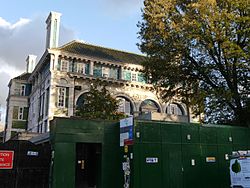Debenham House
| Debenham House | |
| Middlesex | |
|---|---|
 Debenham House | |
| Location | |
| Grid reference: | TQ24427969 |
| Location: | 51°30’9"N, 0°12’32"W |
| Village: | Holland Park |
| History | |
| Address: | 8 Addison Road |
| Built 1905–07 | |
| By: | Halsey Ricardo |
| Arts and crafts / Art nouveau | |
| Information | |
| Owned by: | Private |
Debenham House (or Peacock House) at 8 Addison Road, is a large, detached house in the Holland Park area of Middlesex. Built in the Arts and Crafts style by the architect Halsey Ricardo, it is a Grade I listed building.[1]
History
The house was designed in 1905 for department store owner Ernest Ridley Debenham.[2] Debenham had previously lived in another house designed by Ricardo, at 57 Melbury Road in Holland Park.[2] The house only became known as Debenham House after it was sold on Sir Ernest's death.
For a number of years (at least 1955 to 1962), the house was a residential school, London School of Dance, for prospective ballet dancers and dance instructors. In the 1990s it housed the headquarters of Richmond Fellowship and was the venue for Royal Garden Parties.
Architecture
The exterior of Debenham House is Italianate, while the interior style is Arts and Crafts. It is richly coloured everywhere. The main parts of exterior are clad in variegated Royal Doulton Carrara ware with inset panels faced with green and blue Burmantofts bricks. Ricardo was an advocate of ‘structural polychromy’. The glazed materials were also intended to resist the aging effects of the polluted London air. Critic Jonathan Meades has described the house as "structurally stodgy – an alderman dressed as a hippy."[3]
The interior contains tiles designed by William De Morgan, a mosaic dome painted by Gaetano Meo and ceilings painted by Ernest Gimson.[4]
The domed hall, the central interior feature, has a first-floor gallery connecting the upstairs rooms. Decoration throughout the house is extraordinarily lavish. Mosaics depict members of the Debenham family as well as subjects from classical mythology. There are marble and tile fireplaces, stained glass designed by E. S. Prior and mahogany bookcases with Art Nouveau inlays in wood and mother of pearl. The light switches were specially designed and made by the Birmingham Guild of Handicraft.[3]
Filming location
- Films:
- Trottie True (1949)
- The Wings of the Dove (1997 film) prominently the interior
- Secret Ceremony (1968) used the exterior as the residence of the character Leonora[5]
- Television series:
- What the Butler Saw
Outside links
| ("Wikimedia Commons" has material about Debenham House) |
References
- ↑ National Heritage List 1080783: Debenham House (Grade I listing)
- ↑ 2.0 2.1 "Survey of London: volume 37: Northern Kensington". British History Online. http://www.british-history.ac.uk/report.aspx?compid=49871. Retrieved 2012-06-28.
- ↑ 4.0 4.1 Phillippa Bennett (1 September 2010). William Morris in the Twenty-First Century. Peter Lang. pp. 50–. ISBN 978-3-0343-0106-0. https://books.google.com/books?id=IVZhy3L4HY4C&pg=PA50. Retrieved 25 January 2013.
- ↑ Derek Pykett (20 July 2008). British Horror Film Locations. McFarland. pp. 105–. ISBN 978-0-7864-3329-2. https://books.google.com/books?id=atktMkuOvPwC&pg=PA105. Retrieved 24 January 2013.
- ↑ "Poirot Locations – Lord Edgware Dies". tvlocations.net. http://www.tvlocations.net/lordedgware.htm. Retrieved 1 February 2015.
- ↑ Eirik. "Investigating Agatha Christie's Poirot: Episode-by-episode: Lord Edgware Dies". investigatingpoirot.blogspot.com.es. http://investigatingpoirot.blogspot.com.es/2013/08/episode-by-episode-lord-edgware-dies.html. Retrieved 1 February 2015.
Books
- Stourton, James (2012). Great Houses of London. London: Frances Lincoln. ISBN 978-0-7112-3366-9.